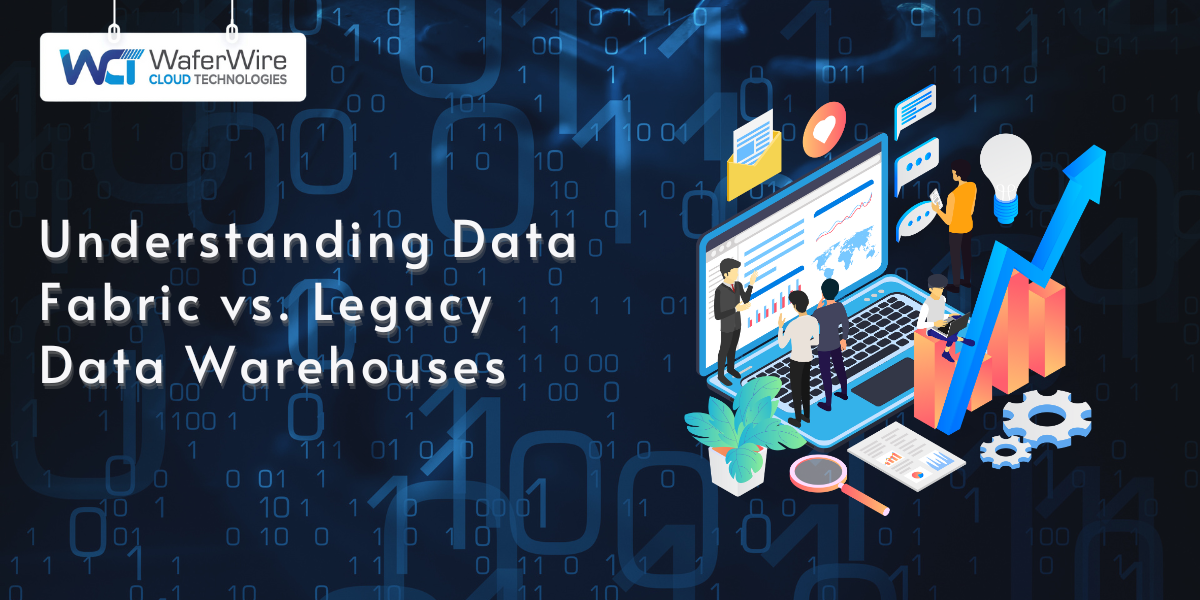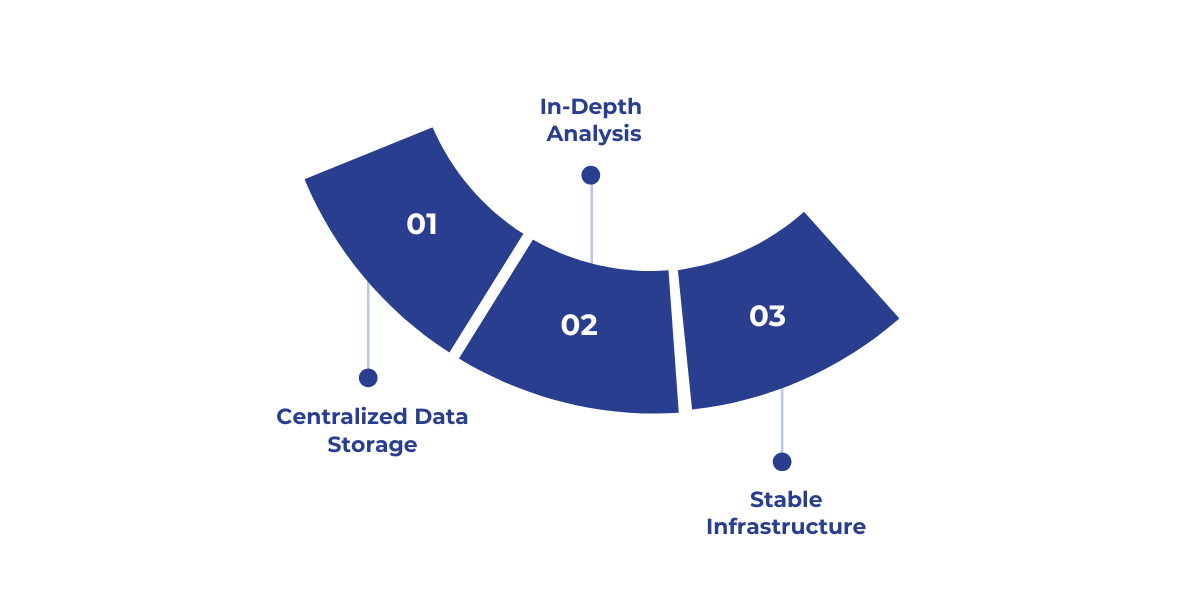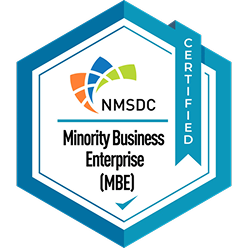

Have you ever wondered how companies manage and make sense of the mountains of data they collect daily? It’s no secret that data is a key asset, but managing it efficiently can be a real challenge. That’s where modern solutions like Data Fabric come in, offering a smarter way to organize, process, and access data in real-time.
On the other hand, legacy data warehouses have been the go-to solution for businesses for years, helping to centralize and analyze vast amounts of data.
In this blog, we’ll walk you through the key differences between Data Fabric and Legacy Data Warehouses, so you can make an informed decision about which solution is right for your business. By the end of this blog, you'll have a clear understanding of both and how they fit into the modern data ecosystem.
Data Fabric is a modern approach to managing and integrating data across diverse environments. Imagine it as a web that connects all your data sources, allowing you to access and use data without worrying about the complexities of how and where it's stored.
Data Fabric uses technologies like Artificial Intelligence (AI) and machine learning to automate data integration, enhance data quality, and enable intelligent data routing across various systems.
The goal of Data Fabric is to simplify data access and make it available wherever and whenever it's needed, eliminating the need for complex data movement, transformation, and integration tasks. With this approach, businesses can make real-time, data-driven decisions quickly.
Now that we’ve covered what Data Fabric is, let’s take a look at the benefits it brings to organizations and how it can enhance your data strategy.
Also Read: Understanding Data Fabric: Key Uses and Trends

Data Fabric offers a range of benefits to businesses by simplifying and enhancing data management. Let's look at how it can enhance your ability to use data and support your organization’s growth.
With Data Fabric, your team can access data more easily, regardless of where it’s stored or how it’s structured. This means less time spent trying to locate and process data, and more time using it for analysis and decision-making.
The ability to process data in real time ensures that your business can act on insights as soon as they arise. This is key for industries where immediate action is needed, such as finance, healthcare, and manufacturing.
Traditional data management can be costly because of the complexity and resources involved in moving and transforming data. Data Fabric minimizes these costs by automating many of the processes, reducing the need for manual intervention.
As your business grows, so does the amount of data you generate. Data Fabric is designed to scale seamlessly with your needs, enabling you to manage vast amounts of data without adding significant infrastructure.
By improving how data is managed, Data Fabric helps businesses gain greater value from their data, enabling better decision-making and growth.
Next, let’s move on to discuss Legacy Data Warehouses and what makes them an enduring solution for many businesses.
A legacy data warehouse is a large, centralized repository where data from different sources within an organization is stored after undergoing the ETL process: Extracting data from sources, transforming it into a consistent format, and loading it into the warehouse for analysis.
These data warehouses were designed to handle structured data, which enables them to efficiently organize large volumes of information in a standardized format. However, as businesses now deal with more unstructured data and require real-time access, legacy data warehouses are starting to show their age, struggling to keep up with the increasing demands of modern businesses.
Now that we understand how Legacy Data Warehouses work, let’s explore the benefits they offer to businesses that rely on traditional data systems.

Legacy Data Warehouses have been a reliable solution for businesses over the years. Let's see how they continue to provide value in organizing and managing large amounts of data for key business activities.
A legacy data warehouse consolidates all your business data in one location, making it easy to access and analyze large datasets. This centralized approach is great for businesses that need in-depth, historical reporting.
Since data in a warehouse is cleaned and transformed, it’s ready for analysis. This makes legacy data warehouses an excellent choice for business intelligence (BI) reporting, where you need historical and structured data for decision-making.
Legacy data warehouses have been around for a long time, meaning they come with well-established infrastructure that many businesses are familiar with. They provide a proven and reliable system for data storage and analysis.
With the benefits of Legacy Data Warehouses in mind, let’s compare them with Data Fabric to understand how these two data solutions differ in their approach and capabilities.
Data Fabric vs. Legacy Data Warehouses: The two solutions have distinct characteristics. Comparison between the two will help you understand which solution might be the best fit for your business needs.
Let’s break down their key differences:
Data Fabric and Legacy Data Warehouses each have their unique strengths. But how can these two systems work together? Let’s look at how Data Fabric and Legacy Data Warehouses can complement each other in a modern data ecosystem.
While Data Fabric and Legacy Data Warehouses are designed for different purposes, they can actually complement each other.
Data Fabric can help modernize and enhance the capabilities of a legacy data warehouse by providing real-time access to the data stored within it. In some scenarios, businesses might use a data warehouse for long-term, historical data storage and rely on Data Fabric to integrate and manage real-time data streams from various sources.
This hybrid approach allows businesses to get the best of both worlds: solid, structured data storage along with agile, real-time insights.
As businesses continue to rely on data to drive decisions and growth, understanding how to effectively manage it is more important than ever. While legacy data warehouses have served their purpose for decades, modern solutions like Data Fabric are pushing the boundaries of what’s possible with data. If your business is looking to stay ahead of the curve with real-time insights and scalable data solutions, embracing Data Fabric could be the next step in your data strategy.
At WaferWire, we specialize in helping businesses like yours modernize their data architecture. Whether you’re transitioning to a Data Fabric or optimizing your existing data warehouse, our team is here to guide you through every step. Ready to transform your data management strategy? Let’s connect with WaferWire today.
1. What’s the main difference between Data Fabric and a Data Warehouse?
Data Fabric integrates data in real-time from multiple sources and environments, making it more flexible and dynamic. On the other hand, a Data Warehouse is a centralized system used to store historical, structured data, often for reporting and analysis purposes.
2. What are the key stages of data warehousing?
The main stages of data warehousing include data collection, where data is gathered from different sources; data cleaning and transformation to ensure consistency and accuracy; storage of the data in the warehouse; and reporting, which enables analysis and decision-making.
3. How does a Data Warehouse differ from an Operational Data Store (ODS)?
While both store data, a Data Warehouse is designed for long-term storage of historical data and in-depth analysis, whereas an Operational Data Store (ODS) handles more immediate, operational data that is used for day-to-day tasks and real-time decision-making.
4. What are the three types of data architecture?
The three main types of data architecture are centralized, where all data is stored in one place; decentralized, where data is spread across various locations or systems; and hybrid, which combines elements of both centralized and decentralized approaches.
5. What types of Data Warehouses exist?
The types of Data Warehouses include Enterprise Data Warehouses (EDW), which store data for the entire organization; Operational Data Stores (ODS), which focus on current, real-time data; and Data Marts, which are smaller, department-specific data warehouses focused on a particular area of the business.

